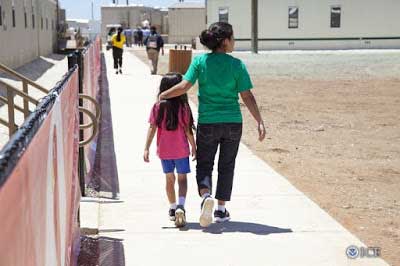I have recently been posting a myriad amount of articles on the atrocities of what is going on with detention centers nationally. With the help of activists, lawyers, and too many to be named, we were able to stop the government from continuing to license the Berks County Residential Center in Berks, Pennsylvania.
Texas has decided to turn up the heat, however, to make up for this “loss.” It will now allow not only these notorious for profit centers to continue, but also it will allow them to become daycare facilities as well.

Virginia Raymond, immigrant lawyer, human rights activist — ex adjunct professor — writes to us the next steps we can take in this battle of David against Goliath, and she shows us her own example, so that we might emulate.
I urge all of us who care about our future as a free society — comprised of diverse human beings — to join in her call and write to any and all who will listen.
Ana M. Fores Tamayo, Adjunct Justice
To all of you who spoke or wrote in opposition to the Texas Department of Family & Protective (sic) Services (DFPS) proposed rule 40 TAC 748.7, which allows ICE and ICE-contract facilities to apply for licensing as “residential child care.”
Thank you.
As you know, we lost the first couple of rounds of that battle. Further rounds to come. Some of you have asked what next. While smarter minds than mine will discuss better ideas, I offer the following suggestions:
1) Write to your state reps and legislators. Know that Senators José Rodríguez, Judith Zaffirini, José Melendez, Rodney Ellis, Sylvia Garcia, John Whitemire, and Kirk Watson wrote to DFPS Commissioner John Specia opposing the rule. Thank them. If you haven’t written to your state rep or legislator asking why DFPS is allowed to ENFORCE immigration law rather than taking care of its business: protecting children, foster children (particularly), those people with disabilities who need its services, and those elderly who are vulnerable, please do so now.
2) Write to DFPS asking them to explain their rationale for the rule adoption in writing. By law, when a person asks during the public comment period, or within 90 days of adopting a rule, for the rationale, the agency must give them a written answer. Mine is below, not because it’s that great, but because it might give you ideas of what to write in your own letter. (I asked questions that are beyond what they are legally required to answer. I hope you ask ALL your questions, too.)
3) Stay tuned (via the Austin American-Statesman especially Andrea Ball and/or the Texas Observer especially via Alex Garcia-Ditta, and/or Grassroots Leadership, RAICES, your local Unitarian church, MALDEF, endfamilydetention.com, the Children’s Defense Fund, the National Association of Social Workers, and others) for the licensure fight and public hearings as to each specific facility.
Thank you.
From: Virginia Raymond
Subject: Questions about new rule 40 TAC 748.7
Date: February 16, 2016 at 11:51:06 AM CST
To: “Carmical,Audrey (DFPS)” , “Ge,Brian (DFPS)” , “Woodruff,Trevor A (DFPS)” , DFPS CCL Rules
 Dear Ms. Carmical, Mr. Ge, and Mr. Woodruff,
Dear Ms. Carmical, Mr. Ge, and Mr. Woodruff,
I have a few questions concerning 40 TAC 748.7, recently adopted by HHSC after DFPS “passed it on” to the larger entity, and hoping one of you might be able to answer them.
First, when I submitted my written comments and when I testified orally, I asked for DFPS to provide me with a written explanation of the rationale for its decision. When should I expect that response? If for some reason, my request was not clear, please also take this note as a request that I am making within 90 days of the agency’s decision for the written rationale for adoption of the rule.
Second, I have not yet seen the rule as adopted by HHSC. Did the agency adopt 40 TAC 748.7 as it was proposed, or did the agency make any changes? For instance, MANY people objected to the illogical and deeply discriminatory exemptions that would apply to ICE and ICE-contract facilities: that these facilities would not have to comply with the rules that other residential child care facilities must as to unrelated adults and children sleeping in the same rooms, opposite-gender children sleeping in the same room, and the total number of people sleeping in the same room. Does the rule as adopted have these same exemptions?

My third question is a combination of my first two. Specifically with respect to the exemptions: is there a rationale for having different (lower & less protective) residential child care standards for refugee children than for all other children? Did your department or the HHSC consider the requirement that Texas must provide equal protection of its laws to persons within its jurisdiction, pursuant to the Fourteenth Amendment to the U.S. Constitution? Did you consider that part of the U.S. Supreme Court’s decision in Plyler v. Doe (1982) that says that states must not punish undocumented children for the acts of their parents, even if or when those acts are illegal? (Of course, none of us believe that the refugees’ acts were illegal: coming to the U.S. and asking for asylum is an act protected by international law as well as by federal statute.)
My fourth question is where I might read the rule as adopted.
My final questions have to do with process. My understanding was that DFPS would consider the rule and all the comments, and then make a decision. I did not realize that HHSC would also have a role. Could DFPS have adopted or rejected the rule itself following the public comment period, or was HHSC action required? Do most DFPS rules go through HHSC, or was the forwarding of proposed rule 40 TAC 748.7 to HHSC an unusual step?
Thank you in advance for your reply.
Sincerely,
Virginia Raymond
—
Virginia Marie Raymond, JD, PhD
Lawyer/Abogada
1006 East César Chávez Street
Austin, Texas 78702
512.472.6270 office
512.748.0940 cell
512.472.8263 fax
www.virginiaraymond.com
virginiaraymond@austin.rr.com
ABOUT THE AUTHORVirginia Raymond is a lawyer, teacher, oral historian, and scholar. She moved to Austin in 1982 for law school and stayed, raising a daughter and two sons wtih Tom Kolker. She is currently involved in much pro bono work defending therights of defenseless immigrants and refugees, too extensive to write. Hence, this is her website, where you can learn all about this formidable human rights activist.
Leave a Reply